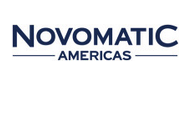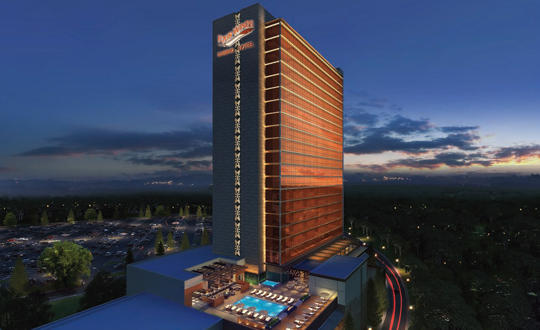
Bring back the aggressive gaming approach.
Tribal leaders and design firms say the “be-safe” phrase is morphing into “go-big” for the new post-pandemic world. Pent-up demand meets the resumption of competition, requiring tribal leaders to perform a balancing act. Operators seek the sweet spot incorporating must-see attractions, comfortable environments and realistic budgets.
As the American market emerges from Covid-19, projects become more forward-looking, far-reaching and sophisticated. Some of the nation’s most prominent companies help tribal leaders step forward.
Project Optimism
HBG Design unveils several operations with tribal leaders positioning themselves both for near-term and long-term success. Dike Bacon, principal, notes that U.S. commercial gaming revenues set an all-time record in gross revenue of $53 billion in 2021.
If this is any indication of the health and vitality of the Indian gaming industry (NIGC has not released 2021 figures), business is booming, he says. “Visit any casino in almost any domestic market and customer traffic is extraordinarily strong—inflation notwithstanding—and you see that demand is there,” he says.
Drivable trips are answering the call of most travelers’ curiosity, which has fueled the need to create fresh and exciting offerings in regional markets where many tribal casinos are located, he adds.
“Competition and location are often the driving forces behind whether a property needs a ‘must-see attraction’ as a differentiator and a draw, but any such ‘wow factor’ has to align with the property’s brand and target audience,” Bacon says.
“I’ll give you an example—we’re designing a distinctive feature attraction for events, music, daytime leisure and active nightlife, as part of a tribal casino resort expansion. The property has a formidable reputation as a leading entertainment and gaming destination, located within 30 miles of a metro feeder market of over 1 million people.
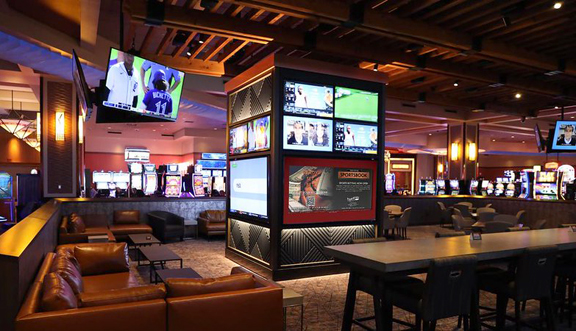
Four Winds South Bend, South Bend, Indiana, hotel tower (abv.) and sportsbook
“Properties like this are able to support large-scale, high-impact, must-see attractions when their location combines a vibrant, diverse local population base and access to an equally strong destination customer who is willing to drive farther and stay longer to experience a distinctive amenity that is unmatched in the regional market.”
Bacon says HBG seeks innovative ways to help clients do more with less.
“This challenge covers a lot of ground, from designing public spaces and guest rooms that are easier and faster to clean and service to moving towards automation in concierge and casino hotel check-in,” he says. “Clearly, one of the biggest challenges for operators is to capitalize on current demand while still offering a great entertainment and hospitality experience with impressive customer service. Staffing in the entire hospitality industry (not just gaming) has been incredibly challenging.”
HBG designers work alongside owners to address these pressing issues. This includes creating more efficiently designed spaces that are exciting and entertaining but can also be operated with less staff.
“We’re creating more efficient kitchens and more diverse means of providing F&B to customers, including self-service and take-out venues. Valet parking is another key service area affected by staffing shortages,” says Bacon.
“More customers may be encouraged to self-park instead of valet, which means designing and locating parking garages that are more convenient, secure and customer-friendly. It also gives rise to designing more elevated and exclusive VIP entrance experiences reserved for a property’s best players, creating a smaller staffing pool to focus service on the largest contributors to the casino’s bottom line.”
Nathan Peak, AIA, LEED GA, practice leader/principal of HBG Design, says pent-up demand for entertainment and hospitality experiences motivate tribes to upgrade underperforming areas of their facilities.
“Given the performance of the industry and how it is bouncing back from the pandemic, we are confident that owners will remain in expansion and renovation mode for a while,” Peak says. “A client recently told us that their gaming resort property will likely be in a continuous state of evolution, renovation and building over the next several years to stay fresh for guests and maintain relevancy in the market.”
Another major influencer of the “continuous state of evolution” mindset is the continued passing of new legislation that drives change in tribal—and commercial—gaming properties, says Peak. As more states pass sportsbook legalization, that sets up new priorities for gaming properties who need “must-have” amenities to compete.
Tribes Take Assertive Stance
“Tribal gaming is definitely staying aggressive in terms of maintaining market share, especially in areas of the country where commercial gaming is growing and evolving,” adds Joe Baruffaldi, AIA, principal/project manager at HBG Design, and leader of HBG Design’s San Diego office.
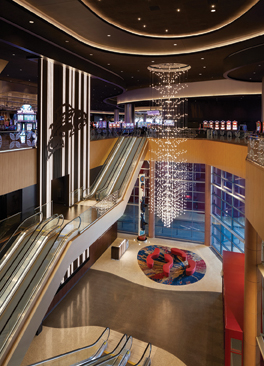
Emerald Queen Casino Resort, Tacoma, Washington
“Tribes realize that knowledge is power; it’s what fuels a competitive edge,” he says. “There’s a greater need today for tribal casino owners to understand the nature of their customer base and harness the power of that knowledge—appreciating and leveraging not only where guests are coming from, but who they are as consumers.
“We partner with tribal gaming clients by helping them envision what the ‘tomorrow of their market’ looks like. When we’re able to anticipate changes in the marketplace, we can proactively respond by leading our clients to more competitively positioned design solutions.”
One of the highlights for HBG over the last few years has been its involvement in in the Four Winds South Bend casino in Indiana. The property is owned by the Pokagon Band of Potawatomi Indians, which operates three other casinos in Michigan.
Four Winds Casino embarks on a large-scale expansion of its South Bend property, designed by HBG, offering approachable luxury within a new 23-story, 317-key, 83-suite hotel tower.
The project includes a mix of vibrant amenities, to include a spa, convention area, meeting space, a ballroom, lounge, bar and grill, an outdoor rooftop swimming pool, and terraces with spectacular views.
The design incorporates regional elements and warm, rustic details with special attention and references to tribal influences and symbolism.
Combining Finance and Intelligence
“To remain competitive, tribes must make sure their facilities are an attractive destination as well as a local favorite,” says Brett Ewing, AIA, principal and executive director at Cuningham Group.
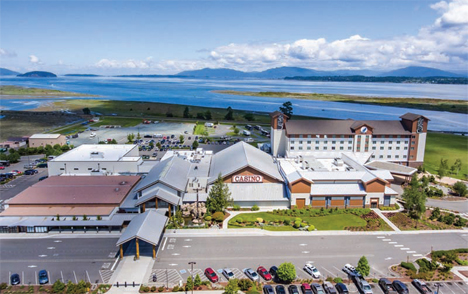
Swinomish Casino and Lodge, Anacortes, Washington
“Tribes should invest in dynamic spaces that allow for flexibility during changing times. Fantastic must-see attractions are compelling (and can be expensive). However, they must also have long-term benefits that entice guests to return time and time again. To achieve this, tribes should consider working with well-known entertainment brands that offer multi-event experiences.”
Leveraging new technology that is exciting for younger customers is another approach, he adds. Comfort and excitement can also be combined to help tribal gaming facilities remain competitive. Spaces should incorporate lasting materials and engaging services that make sense for customers to visit for years to come.
“Cuningham’s tribal gaming clients are not afraid of upgrading their spaces to create innovative and exciting spaces for customers,” he says. “Yet, we never encourage clients to create environments out of fear of not being able to compete. Rather, we ask them to consider what resonates with them and what experiences they want to share with their customers.
“For instance, we are designing the largest Gordon Ramsay Hell’s Kitchen restaurant to date for the Rincon Band of Luiseño Indians (in San Diego County), because the tribe had closed their buffet during the pandemic and they had the perfect opportunity to reimagine the space into an amazing restaurant. The project is scheduled to open this summer.”
The Emerald Queen Casino Resort in suburban Tacoma, Washington balances the eye-catching flash of a Las Vegas-style resort with memorable references to Puyallup tribal culture, he says.
Cuningham worked closely with the Puyallup Tribe to relocate the tribe’s existing gaming operations to a highly visible site along Interstate 5 near downtown Tacoma.
“Together, we found an innovative solution to fitting a large gaming facility gracefully into the urban city fabric,” Ewing says. “Due to site and infrastructure constraints, the gaming floor and amenities are strategically placed four levels above the ground floor, spanning over the city streets and supported structurally by two parking garages.
“This approach creates a breathtaking building that is visible from the highway and provides panoramic views to downtown and to the culturally significant Mt. Rainier and Puget Sound. The destination totals 310,000 square feet and includes approximately 100,000 square feet of slots and table games, a 2,000-seat event center, five food and beverage venues, two parking garages, and a 12-story, 155-room hotel.”
Cuningham’s work on the expansion of the Spokane Tribe Casino in Airway Heights, Washington is part of a larger, multimillion-dollar economic development plan that incorporates a hotel, convention center, dining, retail stores, entertainment venue, and a cultural center on the 145-acre site on U.S. Highway 2.
The casino expansion, which is currently under construction, will double the size of the casino floor. With 20,000 square feet of additional gaming space, the casino will be able to add more than 300 new slot machines and six table games. It also brings a large area for nonsmokers, a dedicated poker room, a sportsbook area, and new dining options.
In Lemoore, California, Cuningham collaborates with the Tachi-Yokut Tribe on an estimated $90 million, 24,000-square-foot expansion and remodel of the existing Tachi Palace Casino. The overall design goal is to modernize the entire gaming floor and give the property a fresh look.
After completion, it will include an expansive sports bar with the flexibility of both indoor and outdoor dining options, an expanded food market, and a new high-limit room. The layout will feature a more open plan, and symmetrical space with a new sculptural porte cochère that provides a sense of entry. The design is reflective of the Tachi tribe and their historic landscapes.
The guest arrival experience and flow into the building are inspired by the sloughs that run through the tribe’s native lands. This provides a strong connection to the nature of the landscape and the conceptual design developed by the Cuningham team.
The renovations also enhance improvements necessitated by the pandemic, including new HVAC and air purification systems, contactless technology, sanitizing stations, and additional space between gaming machines and tables. The buffet space has been replaced with a high-limit room and a grab-and-go market.
Boom Time
“The outlook for casino gaming resort properties is more exciting than ever,” says John Hinton, the director of Native American projects for Bergman Walls & Associates (BWA).

Event Center, Apache Casino, Lawton, Oklahoma
“While changing consumer tastes and the pressure to attract new and different types of customers have always and will continue to drive casino facility design decisions, it also presents a world of possibility. Today’s properties can feature both fantastic must-see attractions and exciting amenities that attract new patrons, as well as environments that are comfortable and familiar for existing patrons.
“If there is anything we have learned in recent years, particularly since the pandemic, it’s that flexibility, both in design and being open to new offerings, is key.”
Many of Bergman Walls’ recent and current projects have included designing flexible casino floors, as well as conference, event and entertainment spaces that can be easily be adapted or modified to meet ever-changing needs and demands.
The BWA design team has extensive experience conceptualizing, master-planning and designing gaming, entertainment, hospitality and mixed-use projects for both commercial and tribal gaming clients, he says.
One of BWA’s recent projects, Swinomish Casino and Lodge in Anacortes, Washington, added flexible event and entertainment spaces, along with a casino floor expansion that can easily accommodate future updates, a hotel tower renovation, and dynamic new dining and retail options.
For the Apache Casino Hotel in Lawton, Oklahoma, BWA remodeled portions of the existing casino and designed a major new event center that can be divided into smaller rooms for conferences or special events.
“As trusted advisers to our tribal gaming clients, what is essential now and in the future is being able to effectively identify trends they may not be aware of, or where we see opportunities at their properties,” Hinton says. “Can a simple renovation or refresh project create renewed interest? Can a fast-casual or upscale food hall and food trucks be a more cost-effective alternate to the traditional buffet, while creating new dining excitement?
“Can other buffets be updated with high-end finishes and upscale food offerings that transform tired spaces into destinations that keep diners and their dollars on site? Is their property prime for incorporating family-friendly or non-gaming amenities that make it a regional destination, while creating new revenue generation opportunities?”
BWA, in conjunction with Kenneth-Ussenko Design, completed an expansion at Morongo Casino Resort & Spa in Cabazon, California. It included a 65,000-square-foot casino gaming floor expansion that increased the size of the gaming floor by 30 percent, with new slots and table games, and a number of new bars and restaurants.
BWA also is currently working on tribal gaming projects in California and Washington that include master planning, sportsbook lounges and sports bars, hotels, a variety of dining and entertainment options, and other new amenities.
“What is also exciting for both BWA and our clients is that even though engagement in today’s sports betting and esports games can take place from virtually anywhere, sports fans and younger patrons are showing they want the experience of being engaged in a more communal setting with like-minded fans and players, with digital and virtual, interactive experiences,” Hinton says.
“And while these demographics are coming for the sportsbooks and esports lounges, they are enjoying other amenities on the properties, including live entertainment, spa experiences, and even traditional table games (albeit electronic ones) and slot machines that will continue to bring in the traditional casino customer who expects the familiar, but elevated offerings.”
This is a game-changer, he asserts, because it shows that today’s casino resort environment can offer something for everyone, with careful thought, strategic master planning and design execution, and effective marketing.
Throughout the industry, an awareness has returned that it’s time to compete. The pandemic left a huge financial and emotional footprint on all businesses, but the spirit of renewal has arrived. The sun has come up again.
Time to be aggressive.














